德国简介英文版
德国简介(英文版)

No sense of humor
Work carefully and Responsible
See the Germans from Example
Rigorous and Earnest
If lost some money in the street, the British never panic, at most, he’ll shrug his shoulders and still very gentlemanly walked up, as if nothing had happened; Americans likely calls the police, after reporting a case to the security authorities and leave a phone, then chew chewing gum and flicking; Japanese must be hate his own carelessness very much and makes re-examination when back home,and never let it happens secondly. But the German is different. He will be on the lost sites and picture coordinates and grid within 100 square meters. Then look for the money grid by grid with a magnifying glass.
Germany is located in Western Europe. East neighboured Poland, the Czech republic, South by Austria and Switzerland, West meets Netherlands, Belgium, Luxembourg, France, North and Denmark connected and adjacent north and Baltic sea and the Nordic countries facing each other across the sea.
德国介绍(中英文双语版)
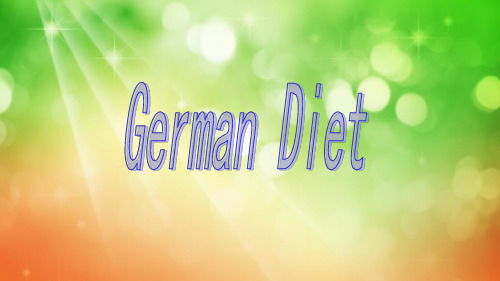
1 葡萄酒wine
German wine produces in 13 wine-growing regions, 65,000 grape growers scattered in these areas. In German wines, the white wines accounted for 65%, the remaining 35% for red wine. In a total of 900 million liters of annual production, about a quarter of it exports to foreign countries.
German diet
Like most areas in China, there are three meals a day in Germany. While the most rich meal isn’t lunch or dinner but breakfast. German staple food are wheat ,bread,and potatoes. Also Germans like to eat cheese sausage match with lettuce salad and fruit. Germans like light sweet and sour, not eating greasy food, or spicy. In the drink, Germans love to drink beer and wine.
4 黑森林蛋糕Black Forest cake
Black forest cake is a chocolate layer cake, heavy with cherries and swathed in loads of whipped(烤的) cream. The sour cherries and sweet chocolate are so good together that one can understand why this has become one of the most desired cakes world-wide.
介绍德国的英文作文

介绍德国的英文作文英文:Germany is a country located in central Europe and has a population of over 83 million people. It is known for its rich history, culture, and technological advancements. The official language spoken in Germany is German, but many people also speak English fluently.Germany has a strong economy and is home to many famous companies such as Volkswagen, BMW, and Siemens. The country is also known for its high-quality education system, with many universities offering free tuition to both domestic and international students.One of the things I love about Germany is the food. German cuisine is hearty and delicious, with dishes such as schnitzel, sausages, and sauerkraut. They also have a wide range of beers, with Oktoberfest being a popular event to celebrate beer and German culture.Another aspect of German culture that I admire is their love for the environment. They have a strong commitment to renewable energy and have made significant strides in reducing their carbon footprint. They also have a great public transportation system, making it easy to get around without a car.Overall, Germany is a beautiful country with a rich culture and history. The people are friendly and welcoming, and there is always something new to discover.中文:德国是位于中欧的国家,拥有超过8300万人口。
德国介绍(中英文双语版)

一年一度的啤酒节(Oktoberfest)让整个城 市都沉浸在欢乐的气氛中,活泼的巴伐利亚人脸上 总是洋溢着笑容,并且这种欢乐和自由的氛围已经 成为吸引世界各地旅游者的一个重要因素。
12
慕尼黑
目的地指南 景点介绍 发现新堡 文化地理
新天鹅堡(New Swan Stone Castle )如果世界上只允许有一座童话城堡存在,那它的名字一定是新天鹅堡
德国电影博物馆
German Film Museum
在法兰克福,你能找到全德国最杰出 的电影艺术博物馆;位于波兹坦广场 的这座博物馆是德国有史以来第一座 以电影为主题的展览馆。
一楼,着重以物品编年史的手法 向游客展出电影的发展历程,
包括:雷诺1882年发明的“实用镜” ,爱迪生1889年发明的活动电影放映 机,卢米埃兄弟1895年发明的“电影 机” 的复制品等;
这座城堡是巴伐利亚国王路德维希二世的行宫,位于慕尼黑以南的阿尔卑 斯山麓,建于1869年。
从奥格斯堡到富森,光是坐火车一路的风景都会让遐思神往。这犹如人间仙 境的地方藏着有关魔法、国王,骑士的古老的民间传说,还有那无边原始的森 林、柔嫩的山坡、无边的绿野上漫步着成群的牛羊,积雪终年的阿尔卑斯山和 无尽宽阔的大湖
14
目的地指南
【其他活动】:
慕尼黑啤酒节(The Munich Oktoberfest) 【时间】:每年的九月末到十月初,在慕尼黑举行,持续两周; 【介绍】:慕尼黑啤酒节原名“十月节”,起源1810年10月12日,因为在这个节日期间主要
的饮料是啤酒,所以人们习惯性地称其为啤酒节。每年九月末到十月初举行,持续 两周,是慕尼黑一年中最盛大的活动,也是世界三大啤酒节之一。 【活动】:开幕式,盛装巡游(最热闹),啤酒帐篷,特色餐饮2国概况OVERVIEW
德国简介(英文综合版)

GEOGRAPHY
Germany is traversed by some of Europe‘s major rivers such as the Rhine(莱茵河) and Danube (多瑙河). Thanks to its central situation Germany has more neighbors than any other European country; these are Denmark(丹麦)in the north, Poland (波兰)and the Czech Republic(捷克共和国)in the east, Austria奥地利and Switzer(瑞士)land in the south, France and Luxembourg卢(森堡)in the south-west and Belgium(比利时)and the Netherlands(荷兰)in the north-west.
Exports Export goods Main export partners
€1.146 trillion (2010) machinery, vehicles, chemicals, metals and manufactures, foodstuffs, textiles France 10.2%, U.S. 6.7%, Netherlands 6.7%, U.K. 6.6%, Italy 6.3%, Austria 6%, China 4.5%, Switzerland 4.4% (2009 est.) €1.020 trillion (2010) machinery, vehicles, chemicals, foodstuffs, textiles, metals Netherlands 8.5%, China 8.2%, France 8.2%, U.S. 5.9%, Italy 5.9%, U.K. 4.9%, Belgium 4.3%, Austria 4.3%, Switzerland 4.2% (2009 est.) $1.057 trillion (31 December 2010 est.) $4.713 trillion (30 June 2010)
德国简介(英文)解剖

and polymath. 黑格尔Georg Wilhelm Friedrich Hegel(1770 –1831) was a German philosopher, one of the creators of German Idealism.
Germany is traversed by some of
Europe‘s major rivers such as the Rhine,(莱茵河) and Danube (多瑙 河). Thanks to its central situation
Germany has more neighbors than
The national flower of Germany
国花:The cornflower is the national flower of Germany. It is also called the knapweed.The iking because of their blue color. At present, the flowers are also available in white, pink, and red.矢车菊,又名蓝芙蓉、 荔枝菊、翠蓝,属于菊科。头状花序生在纤 细茎秆的顶端,仿佛一位隽秀的少女,向着 “生命之光”——太阳,祈祷幸福和欢乐。 矢车菊是德国的名花,德国人用她象征日耳 曼民族爱国、乐观、顽强、俭朴的特征,并 认为她有吉祥之兆,因而被誉为“国花”。
any other European country; these are Denmark(丹麦)in the north, Poland (波兰)and the Czech Republic(捷克共和国)in the east, Austria奥地利and Switzer(瑞士)land
德国介绍(中英文双语版)

Data gathering :
幻灯制作: Junta_C
PowrPoint:
文字撰稿: Junta_C
writing:
英文翻译: Junta_C
Translate:
1
德意志联邦共和国
【Country】The Federal Republic of Germany
【Capital】柏林(Berlin)
柏林动物园是德国的第一个动物园。柏林动物园 已迅速发展成为世界上收集动物种 柏林动物园 类最多的大动物园之一,饲养著约885种共 5,350只动物。 著名的特色是布氏馆,是世界上最大动物园建筑 物之一。馆内设有能容纳几百种鸟类的巨大鸟舍 。鸟舍两侧是猫科野兽的笼子以及蜥蜴类和蛇类 的育养箱,而整个建筑又长满了从国外引进的热 带植物。该动物园还有异常巨大的自然露天围栏 ,用于饲养美洲野牛、骆驼、美洲驼以及其他有 蹄类动物,并用于养北极熊。
最现代化的建筑重新定义着城市的轮廓,散发着迷人的诱惑力
8
目的地指南
柏林动物园Berlin zoo
景点信息
开放时间:9:00a.m.-18:30p.m. 冬季 (10.15-03.14)9:00a.m.-17:00p.m. 夏季 (03.03-10.14)9:00a.m.-18:30p.m. 门票价格:成人11EUR;学生8EUR;儿童5,5EUR
【Population】8211万(82.11 million)
【 】柏林 波恩 City
(berlin)
(bonn) and so on……
【Nation】德意志人(Germans)又称日耳曼人
【Religion】基督教(Christian)、天主教(Catholic)
用英文介绍德国,初二作文

用英文介绍德国,初二作文【中英文版】Introducing Germany: A Secondary School CompositionGermany, known as the Federal Republic of Germany, is a fascinating country located in the heart of Europe. With a rich history, diverse culture, and thriving economy, it has always been a prominent player on the global stage. This essay aims to provide a brief introduction to this remarkable nation.德国,全称为德意志联邦共和国,是一个位于欧洲心脏地带的迷人国家。
它拥有悠久的历史、多元的文化和繁荣的经济,一直是全球舞台上的一股重要力量。
本文旨在简要介绍这个非凡的国度。
Berlin, the capital city, serves as a vibrant hub of art, music, and history. The iconic Brandenburg Gate, the Berlin Wall, and the Reichstag Building are just a few of the countless attractions that make this city a must-visit destination for tourists from all over the world.柏林,作为德国的首都,是艺术、音乐和历史的活力中心。
著名的勃兰登堡门、柏林墙和国会大厦只是这个城市无数吸引力的冰山一角,吸引了来自世界各地的游客。
German cuisine is renowned for its variety and flavors. From the famous Bratwurst sausage to the delectable Black Forest Cake, German cuisine offers something for every taste bud. Moreover, the annual Oktoberfest celebration in Munich is a testament to Germany's love forfood, beer, and traditional culture.德国美食以其多样性和口味著称。
德国英文简介

Germany has more people than any country in Europe, not counting Russia. Industry has made Germany wealthy. It is the dominant economic power in Europe. Its factories make steel, cars, cameras, chemicals, and machines of every type. Yet Germany lay in ruins in 1945, after its defeat in World War II.Facts About GermanyOfficial name Federal Republic of GermanyCapital BerlinOfficial language GermanPopulation 82,400,000 peopleRank among countries in population 14thMajor cities Berlin, Hamburg, MunichArea 138,000 square miles 357,000 square kilometersRank among countries in area 62ndHighest point Zugspitze9,718 feet/2,962 metersCurrency EuroGERMANY’S LANDGermany lies at the heart of Europe. Berlin is its capital and largest city. Other European countries border Germany on all sides. But the country has a seacoast to the north, where it meets the Baltic Sea and the North Sea. Hamburg, a city near the North Sea, is Germany’s major seaport.Low-lying plains spread over northern Germany. This is a largely agricultural area. The plains rise to rolling hills in central Germany. Frankfurt is a manufacturing and business center in central Germany. Frankfurters (hot dogs) are named after a sausage made in Frankfurt.Rivers have carved valleys in the hills. The Rhine, a major river of Europe, flows through western Germany. Boats on the Rhine carry freight and passengers. Scenic countryside, picturesque towns, and old castles lie along the Rhine.To the south, Germany extends into the Alps. The Bavarian Alps, as Germany’s mountains are called, include some spectacular scenery and a fairytale castle. The castle was built for Louis II of Bavaria, who issometimes called Mad King Ludwig. The Black Forest—a dense evergreen forest—is in southwestern Germany. It’s a favorite spot for hikers.Munich is the largest city in southern Germany. Every October, people come to Munich for the Oktoberfest. At this lively festival, they drink the beer for which southern Germany is famous.Expressways—known as autobahns—run through Germany and link German cities. Parts of the autobahn have no speed limits. People can drive as fast as they want. Yet there are few accidents. The road is well designed, and most of the cars are German made. They are examples of fine German engineering.WORLD WAR IIOne of the most destructive dictators the world has ever known ruled Germany from 1933 to 1945. His name was Adolf Hitler, and he led the Nazi Party. Hitler rose to power after Germany’s defeat in World War I (1914-1918). He promised to make Germany great again, and he set out to conquer Germany’s neighbors. In 1939, Hitler invaded Poland, starting World War II. The war was long and costly, and Germany lost.DIVIDED AND UNITEDAfter World War II, Germany was divided into two countries: East Germany and West Germany. East Germany had a Communist government and took orders from the Soviet Union. West Germany became a democracy that received support from the United States and other Western powers.The boundary between East Germany and West Germany ran through Berlin. East Germany put up barbed wire along the border. A concrete wall divided Berlin. The Berlin Wall kept East Germans from leaving their country for the wealthier West Germany. With the fall of Communism in 1989, the wall came down. It was a joyous occasion for Germans on both sides. The two Germanys were reunited in 1990.CENTURIES OF DIVISIONGermany has known little unity throughout its history. Until 1871, the land now known as Germany consisted of many small kingdoms. Prussia in the north was the most powerful of these kingdoms. Prussia’s prime minister, Otto von Bismarck, led efforts to unite the kingdoms. In 1871, they came together to form the German Empire. Prussia’s king, William I, was crowned emperor of Germany.GERMAN CULTUREGermany has produced great thinkers, composers, and artists. Johannes Gutenberg, for example, invented the printing press around 1450. He made it possible to publish books. Afterward, more and more people learned to read. A German priest, Martin Luther, broke away from the Roman Catholic Church in 1512. The Protestant churches all grew out of the movement Luther started.German thinkers such as Immanuel Kant, G. W. F. Hegel, and Friedrich Nietzsche wrote key books of western philosophy. The list of German composers contains many of the great names of classical music. George Frideric Handel, Johann Sebastian Bach, Johannes Brahms, Ludwig van Beethoven, Robert Schumann, and Richard Wagner—all were Germans. Albrecht Dürer is Germany’s most important painter.。
介绍德国作文英文

介绍德国作文英文英文,Introduction to Germany。
Germany is a country located in central Europe. It is known for its rich history, culture, and strong economy. As a German, I am proud to share some insights into my country.Firstly, Germany is a country of diverse landscapes and regions. From the mountains in the south to the beaches in the north, there is something for everyone. The Black Forest, Bavarian Alps, and the Rhine Valley are just a few examples of the breathtaking scenery that can be found in Germany.Secondly, Germany is home to many famous historical landmarks and cultural sites. The Brandenburg Gate, Berlin Wall, and Neuschwanstein Castle are just a few of the many attractions that draw millions of visitors each year. Germany is also known for its world-class museums, such as the Berlin Museum Island and the Deutsches Museum in Munich.Thirdly, Germany is famous for its strong economy and technological advancements. Many of the world's largest and most successful companies are based in Germany, such as Volkswagen, BMW, and Siemens. Germany is also a leader in renewable energy and has made significant strides towards achieving a sustainable future.In terms of culture, Germany is known for its beer, sausages, and bread. Oktoberfest is a famous festival that celebrates German beer and culture. Germans are also known for their love of football and have a strong national team that has won multiple World Cup championships.Overall, Germany is a country that has something to offer for everyone. Its rich history, diverse landscapes, strong economy, and unique culture make it a fascinating place to visit or live in.中文,介绍德国。
德国概况英文版8
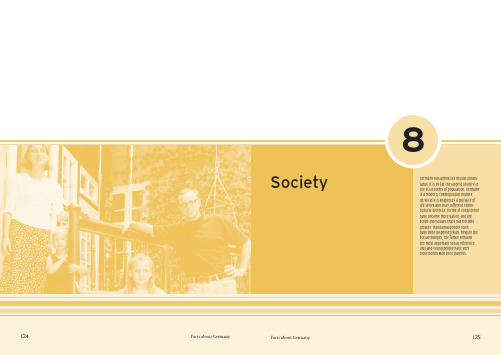
Standard of livingGermany is one of the countries with the highest standard of liv-ing in the world. According to the UN’s HDI Index, Germany is one of the most developed countries in the world in terms of life expectancy, degree of literacy and per-capita income. Thehealthcare system enables com-prehensive medical care, where-by the social security systems of the statutory health insur-ances, care and accidentinsurance and unemployment support protect people against existential risks.By Rainer GeißlerGerman society is a modern,open-minded society: Most people – both young and old – are well-educated and enjoy a high standard of living , as well as sufficient freedom to be able to plan their lives as they themselves see fit. The nucle-us of their lives is the family, which is constantly adopting new forms. Yet society is faced with the challenge of solving important problems such as population trends – the ageing of society as well as immigration, which is increasingly var-ied in terms of ethnic culture. And there is one thing the Ger-mans still have to overcome: the effects of the 45 years dur-ing which the country was divided. In the 15 years since political reunification in 1990 much has happened, and yet restoring the social unity of Germany will remain an impor-tant issue for the foreseeable future.PopulationWith reunification Germany became the country with by far the largest population in the European Union. Almost 83 million people live on German territory, almost one fifth of them in what was formerly East Germany. Three trends are characteristic of demographic developments in Ger-many: a low birth rate, increasing life expectancy and an ageing society.For 30 years now Germany has been witnessing fewbirths: With slight fluctuations, since 1975 the number of newborn infants has been approximately 1.4 children perGerman society – modern, pluralist and open-mindedCross-generational contractThis is the name of the system used to finance statutory pension insurance: employees today pay proportional contributions toward the pensions of the gen-eration of retirees in the expecta-tion that the coming generation will then pay for their pensions. The first mandatory regulations on old-age security were made as long ago as 1889. Today about80 percent of employed persons pay into the statutory pension system. Alongside contributions by the employers and employees, today the system is also funded by government subsidies. Since 2002, statutory pensions have been supplemented by state-sup-ported, private capital-backed old-age provisions.Ways of lifeThere are many different ways of life in Germany, but most peo-ple, or almost 68 million, live in multi-person households. Morethan 43 million of them live as parent/child group combina-tions, and these include just under 21 million children. Justshort of 23 million people live as couple, and yet close to14 million live alone.Single parentsIn more than 90 percent of the 1.5-million plus families in which a single parent brings up the chil-dren, that person is the mother .The family continues to be the key social institutionTrend to more part-time work part-time employment are women –mostly mothers – who do 85 percent of all such jobs. This results in average weekly working hours for men of over 40hours, and for women of only just 31 hoursHome ownershipSportUpbringing Social causesL i v i n gM o b i l i t yF o o d263L e i s u r e t i m e261The most popularleisure time activities Home owners and tenants (in percent)The three largest areas of voluntary service TNS InfratestStatistisches BundesamtStatistisches BundesamtStatistisches BundesamtStatistisches BundesamtT e n a n t s57.8H o m e o w n e r s42.2Tennis 1.8Gymnastics Soccer Shooting1.5The most popular types of sport (in million members)Athletics 0.9Sport Going out DIY/gardening Relaxing at home Cinema Culture High proportion of women in GFKS a l a r i e d s t a f fW o r k e r s31.3C i v i l s e r v a n t s 6.3S e l f -e m p l o y e d 10.8Top jobsWomen account for some 21 per-cent of leading executives in Ger-many, and every third manager is a woman. In Eastern Germany,the ratio of female to male man-agers is far more even. There a good 42 percent of managers are women and as many as 29 per-cent of the key executives are women. In Western Germany, the figures are only 32 and 20 per-cent respectively. The opportuni-ties for women to assume man-agement responsibilities depends strongly on the sector . It is high-est in the service industry, where53percent of managers are women. In the construction industry, by contrast, the figureis only 14percent.Women in the worldof work: Womennow account for 45 per-cent of all employedpersonsLife style of the elder generations Senior citizens are not only grow-ing older , but are healthier , fitter and more active than in the past.They are also economically bet-ter off: the over 60s hold almost a third of total purchasing power .The life style of the 50+ genera-tion has changed considerably,and the silver-agers increasingly prioritize active leisure time.According to an SWR study, here they emphasize nurturing social contacts. The elderly tend to meet friends almost once a week and go to a restaurant on aver-age twice a month. Alongside almost daily viewing TV (news),listening to radio (classic) and reading the paper , they like to do sports – on average five times a month.increasing life expectancy, after Japan and Italy German society has the third-largest proportion of elderly people worldwide. Their ways of life and lifestyles have changed a lot over the last decades. Nowadays the vast majority of eld-erly people lead independent lives. For the most part they live close to their children, with whom they are in close con-tact. Health-wise the “young elderly”, who are younger than 75 or 80, are mostly in a position to carry on living inde-pendent lives with new goals and actively decide how to make use of their leisure time.Financially speaking the elder generation is for themost part taken care of: The 1957 pensions reform gradual-ly gave pensioners a full share in the nation’s wealth. Today it is even possible for them to give their children financial support to start their own family. Poverty in old age has not been done away with entirely, but the risk of being poor in old age is lower than that of other age groups.Pensioners in Eastern Germany are also well off. Theyare among those who have benefited most from reunifica-tion, and are now no longer condemned to live on the periphery of society many of them were forced to inhabit in the former East Germany. Today their income is almost on a par with the Eastern German average, and satisfaction with it is considerably higher than among East Germans younger than 60.Immigration and integrationEver since the 1950s post-war boom the German economy has been dependent on immigrant workers. The majority of those who were at the time referred to as “guest workers”have now returned to their home countries in South and Southeast Europe, but many have stayed on in Germany to earn their keep. Many of the Turkish immigrants that came to Germany at a later date have also remained in the coun-try. This has resulted in Germany gradually developing from a country that accommodated guest workers to a country with regulated immigration.but also with democracy: The pessimistic protest and “can’t be bothered” attitude of the 1980s has for the most part given way to a non-ideological, optimistic pragmatism.Today’s young generation is success-oriented and prepared to work hard. Their maxim of life can be reduced to the for-mula “getting on instead of getting out”.With regard to the traditional left-wing/right-wingdivide, today’s youth is typically positioned somewhat to the left of the population as a whole; only very occasionally are there instances of political extremism. On the other hand there is a high degree of willingness to get involved with social commitment . Some three-quarters of all youngsters are actively committed to social and ecological interests: elder-ly people in need of help, environment and animal protec-tion, the poor, immigrants and the disabled. Interest in pol-itics, political parties and trade unions, on the other hand,is on the decline. Only about 30 percent of 12 to 25-year old youngsters claim to be at all interested in politics, whereas among young adults and students the figure is considerable higher, namely 44 and 64 percent respectively.The elderlyIn Germany, approximately every fourth person is over 60years old. Because of the long-standing low birth rates andSocial commitmentSocial commitment amongyoung people in Germany is grat-ifyingly high. Indeed, 37 percent of the young people in the 14-24year age bracket do voluntary work. They are active on behalf of sports, leisure time, school,cultural and church affairs or in the emergency services. The proportion of young people in some areas is so high that with-out their commitment the ser-vices would collapse – for exam-ple in the field of sports. Half of all young people are members ofclubs, a quarter dedicated to large social organizations, espe-cially to the churches.Young people: Helping others is a self-evidentpart of their lives4.1 1974 4.419847.1 19947.3Foreign populationin millionsStatistisches Bundesamt0.71961Immigration lawIn early 2005 the first Immigra-tion Act in German historycame into force. It distinguishes between limited residence per-mits and unlimited right of residence. At the same time, it also lays down measures to inte-grate immigrants, such as mandatory language courses.Among the foreigners, some 1.8 million persons with Turk-ish citizenship form the largest group. There are also signif-icant numbers of Italians (550,000), immigrants from Serbia-Montenegro (a good 500,000), Greeks (320,000) and Poles (almost 300,000), followed by Croats, Russians, Bosnians,Ukrainians, Portuguese and Spaniards. More than one mil-lion people are refugees.Because Germany specifically recruited a labor forcefor simple activities, many of the immigrant workers are employed as unskilled laborers. Some work as skilled labor-ers but only very few in professions that require high quali-fications. Studies have revealed that immigrant families in Germany find it particularly difficult to improve their social standing and economic position.Nonetheless, over the past decades progress has beenmade with regard to the integration of immigrants: Acquir-ing German citizenship has also been facilitated, contacts between immigrants and Germans are closer, and there is more widespread acceptance of ethnic cultural variety. And the new im m igration law provides for the first time an all-embracing legal framework that considers all aspects of immigration policy – from labor market-oriented and humanitarian immigration through to questions of integra-tion. And yet integration remains a challenge for politicians and society alike. Efforts now focus on improving German language skills, providing enhanced educational opportuni-ties for immigrant children, and measures to prevent dualsocieties and ethnic ghettoes.•Repatriates of German descent, who for generations have been living in the states of the former Soviet Union, Roma-nia and Poland, are a second major group of immigrants.Since the collapse of the communist systems they have been returning to Germany in increasing numbers.These two groups of immigrants resulted in the percapita rate of immigration to Germany in the 1980s being con-siderably higher than that of classic immigration countries such as the USA, Canada and Australia. There are more than seven million foreigners, in other words almost nine percent of the population, living in Germany. In addition there are also 1.5 million foreigners who have taken German citizen-ship, and some 4.5 million repatriates. This means that almost every sixth citizen has either immigrated or stems from an immigrant family. Some 95 percent of foreigners live in Western Germany and primarily in big cities, where in some cases they make up more than 30 percent of the population.ImmigrationAs early as the 19th century Ger-many attracted a large number of immigrants and since the 1950s has emerged as the Euro-pean country with the largest immigrant population. In 1950,there were about 500,000 foreigners in Germany, account-ing for a mere one percent or so of the population. This has changed emphatically: Today,some 7.3 million foreigners live in Germany, or 8.8 percent of the population, including 2.3 million EU citizens. About every fifth foreigner living in Germany wasborn here and is a second or third-generation immigrant.Rainer GeißlerProfessor of Sociology at Siegen University, Geißler is the author of the standard sociology textbook ”Die Sozialstruktur Deutschlands“.the other half Protestants. The new German Ethno-cultural diversity:About every sixth inhabitant is an immigrant or a member of a family of immigrantsLong-term care insuranceLong-term care insurance was introduced in 1995 as the “fifth column” of the social insurance system. The compulsory insur-ance is financed by equal contri-butions by employers and employees. There are plans to extend this financing through provisions covered by capital.financed in the long term: The increasing proportion of eld-erly people in the population in conjunction with a rela-tively low birth rate and trends in the labor market have pushed the social security system to its very limits. By means of extensive reforms politicians are now busy attempting to meet this challenge and ensure a welfare system based on solidarity for coming generations as well.Reform of the health systemGermany is one of the countries with the best medical care.A wide range of hospitals, medical practices and institutions guarantees medical care for everybody. With over four mil-lion jobs, health care is the largest employment sector in Ger-many. All in all, 11.1 percent of the country’s gross domestic product is spent on health – 2.5 percent more than the aver-age in the OECD member countries. As a result of the so-called cost-cutting law introduced in the wake of the reformSocial securityAffluence for everybody and social justice: In the late 1950s that was the goal the then Federal Minister of Eco-nomics Ludwig Erhard had in mind when he introduced the social market economy in Germany. The “German model”proved to be a success story and became an archetype for several other countries. One of the pillars of this success was the extensive German welfare system. Today, Germany boasts one of the most comprehensive welfare systems: 27.4percent of the country’s gross domestic product is chan-neled into public welfare spending. In comparison, the USA invests 14.7 percent, while the OECD average is 20.4 percent.An all-embracing system of health, pension, accident, long-term care, and unem ploym ent insurance provides protection against the financial consequences of the risks we face in everyday life. In addition, the welfare lifeline offers tax-financed services such as the family services equalization scheme (child benefit, tax concessions) or basic provisions for pensioners and those unable to work. Germany sees itself as a welfare state that considers the social protection of all its citizens to be a priority.The welfare-state social systems in Germany have along tradition dating back to the industrial revolution. In the late 19th century, Reich Chancellor Otto von Bismarck devised the principles of the state social insurance scheme;It was under his aegis that the laws relating to accident and health insurance as well as provisions for invalidity and old age were passed. Whereas in those days a mere ten percent of the population benefited from the welfare legislation,nowadays almost 90 percent of people in Germany enjoy its protection.In subsequent decades the welfare lifeline wasexpanded and refined; in 1927, for example, insurance cov-ering the financial consequences of unemployment and, in 1995, long-term care insurance were introduced. The 21st cen-tury calls for a fundamental structural realignment to the systems, in particular with regard to whether they can beUnemployment insuranceIn Germany those with no work can claim support. Anyone who is unemployed and over the past three years has paid contribu-tions to the state unemploymentinsurance system for at leasttwelve months is entitledto unemployment benefit (60 to67 percent of their last net income). This unemployment benefit is financed through the contributions of which employersand employees each pay half.The longest period for which unemployment benefit can be drawn is twelve months and 18 months for those aged 55 or over . After that period those looking for work can apply for basic support (known as “unem-ployment benefit II ”), which is assessed according to the appli-cant’s needs.The welfare stateThe principle of the welfare state is enshrined in Article 20 of the Basic Law and cannot be rescind-ed, even if the Basic Law is changed. In this way the Basic Law commits the state to pro-tect, in addition to their freedom,the natural bases of life of its citi-zens. Each individual, however ,also has to assume responsibilityfor his own social welfare.are plans to replace the current child-raisingPension insuranceThe statutory pension insurance is the most important pillar of old-age provisions. Its financing is split: The monthly contribu-tions paid by employees and employers pay the pensions of those currently in retirement.Through their contributions,those insured acquire some rights when they themselves become pensioners. In turn, com-ing generations provide for these future rents with their contribu-tions (cross-generational con-tract). In addition, company and private pensions are thesecond and third pillars of provi-sions for old age. Under certain conditions these also enjoy gov-ernment support.ple’s insurance” (SPD). The government plans to present a feasible solution to this complex question in 2006.Pension reformFundamental changes are also planned for provisions in old age. Although compulsory pension insurance will remain the single most important pillar of income in old age, in-com-pany and private pension schemes are becoming more and more important. The so-called “Riester pension”, named after former Minister of Social Affairs Walter Riester, is one such model already in existence that by means of tax con-cessions makes possible private pension schemes covered by capital contributions. For reasons of justice between gener-ations, the pensions to which the current generation of pen-sioners is entitled are not being increased.The government has also resolved to raise the age ofretirement from 65 to 67: Between 2012 and 2035 it will be raised one month every year. At the same time an incentive scheme known as “Initiative 50 Plus” is geared to improving opportunities for older employees.Further reformsThe reform of support for the long-term unemployed and those receiving social assistance has already been imple-mented. With the introduction of basic support for the unemployed those who had formerly been receiving social security, as long as they were capable of working, were put on a par with the long-term unemployed. The reform of the accident insurance scheme, aimed primarily at reforming theorganizational framework, is still outstanding.•already undertaken to the health system, Germany now makes the lowest per capita increase to health spending of all OECD countries: Between 1998 and 2003 spending rose in real terms by 3.8 percent per annum, while the OECD mean was 4.5 percent.Yet in order to ensure that spending is adapted to thealtered conditions there is still a need for further reform. As such the grand coalition is striving for a fundamental struc-tural reform of the health system and also to make the health insurance systems fit for the future. To this end the coalition parties in government have devised different concepts,which, however, are not necessarily compatible: the “soli-darity system health premium” (CDU and CSU) and the “peo-Health insuranceAlmost all citizens in Germany have health insurance, whetheras a compulsory member of the statutory health insurance scheme (88 percent) or a private health insurance scheme (almost 12 percent). The health insurancecompanies cover the cost of medical treatment, medication,hospitalization and preventive health care. Contributions to thehealth insurance scheme are made by employees and employ-ers. Non-employed family mem-bers of those in a compulsory health insurance scheme do notpay any contributions.Accident insuranceStatutory accident insurance is aliability insurance on the part of employers in favor of employ-ees who are thereby protectedfrom the consequences of an accident at work or an occu-pational disease.Social assistanceAnother feature of the social lifeline is social assistance, which is financed through taxes. It comes into effect when people are unable to escape their plight on their own and by their own means or by those of relatives.As such, there is basic protection in old age or in the case of long-term unemployment as well as state help towards living or to assist persons in certain predica-ments.High standards: Germany is one of the countries withthe best medical care。
德国历史介绍英文版

德国历史介绍英文版Germany has a rich and complex history that has significantly shaped the country and had an impact on the world. From its early beginnings to its post-war reconstruction, Germany's history is marked by various political, cultural, and economic developments.The earliest known inhabitants of what is now Germany were tribes of Germanic peoples, such as the Saxons, Franks, and Bavarians. These tribes eventually united under the leadership of Charlemagne, who established the Holy Roman Empire in 800 AD. It was during this time that Christianity was introduced to the region.In the following centuries, the Holy Roman Empire was dissolved, and the German states became fragmented. This era, known as the Middle Ages, was characterized by feudalism and conflicts between local lords. It wasn't until the late 15th century that the German states began to consolidate under the rule of the Habsburg dynasty.The 16th century brought significant religious and political changes to Germany with the Protestant Reformation led by Martin Luther. This movement challenged the authority of the Roman Catholic Church and resulted in the division of Christianity into Catholicism and Protestantism.The 17th and 18th centuries were marked by various wars, such as the Thirty Years' War and the War of Austrian Succession. These conflicts devastated the region and led to significant territorial changes. Germany also experienced an age of enlightenmentduring this period, with notable philosophers and thinkers emerging, such as Immanuel Kant and Johann Wolfgang von Goethe.In the late 18th and early 19th centuries, Germany witnessed the emergence of a national consciousness known as German nationalism. This sentiment culminated in the formation of the German Confederation in 1815, which aimed to unite the various German states under one political entity.The 19th century also saw the industrial revolution and the rise of modern nationalism in Germany. The country experienced rapid industrialization, economic growth, and increased political tensions. This eventually led to the unification of Germany under the leadership of Prussia in 1871, creating the German Empire.Germany's imperial ambitions in the early 20th century led to its involvement in World War I. The war ended in defeat for Germany and resulted in significant political and social instability. This period of turmoil eventually paved the way for the rise of Adolf Hitler and the Nazi Party.Under Nazi rule, Germany pursued a policy of territorial expansion and implemented a systematic genocide against Jews and other minority groups during World War II. Germany's defeat in 1945 marked the end of the Nazi regime and led to the division of the country into East Germany (German Democratic Republic) and West Germany (Federal Republic of Germany) during the Cold War.The fall of the Berlin Wall in 1989 symbolized the reunification of Germany and the end of the Cold War. Since then, Germany has become a leading economic and political power in Europe. It is known for its technological advancements, strong social welfare system, and commitment to democracy.Germany's history is a complex tapestry of triumphs and tragedies, with moments of great achievements and painful introspection. Today, the country continues to grapple with its past while striving for a prosperous and peaceful future.。
德国英文简介参考PPT
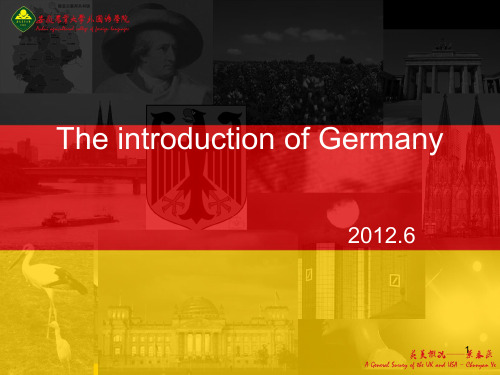
2
The state government to parliament a republic. The President is head of state. The federal government by the federal prime minister and federal minister of certain people, the federal prime minister for the heads of government. Germany is a founding member of the European Union, is the United Nations, the north Atlantic treaty organization, the g8, the union for the Mediterranean members.
black hawk symbolizes
strength and courage. In
1950 the German national
emblem is formulated the
products of history.
9
Its design for a gold yellow shield emblem features a unique style of black eagle, hawk beak, claw are red. The design of the twelfth century came from the earliest HuoHeng sauron family, this family has ruled Prussia, and later became the German royal family. To the eagle in figure, as early as the ninth century had appeared. It is said that, this design is by frank king Charles I troops from the Roman empire to Germany.
德国简介作文英文
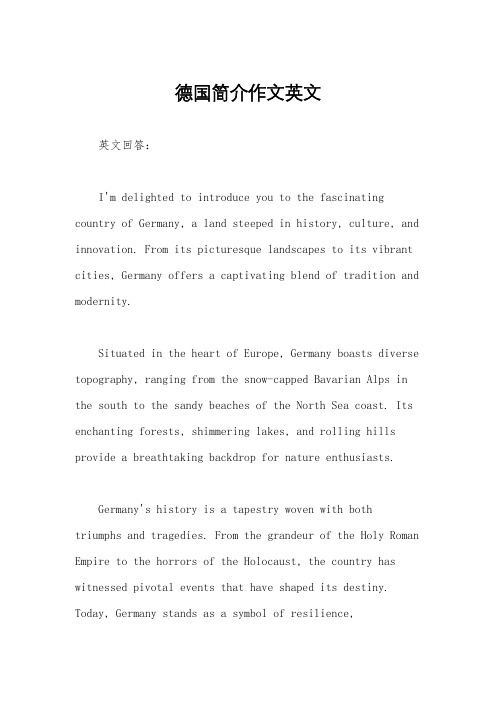
德国简介作文英文英文回答:I'm delighted to introduce you to the fascinating country of Germany, a land steeped in history, culture, and innovation. From its picturesque landscapes to its vibrant cities, Germany offers a captivating blend of tradition and modernity.Situated in the heart of Europe, Germany boasts diverse topography, ranging from the snow-capped Bavarian Alps in the south to the sandy beaches of the North Sea coast. Its enchanting forests, shimmering lakes, and rolling hills provide a breathtaking backdrop for nature enthusiasts.Germany's history is a tapestry woven with both triumphs and tragedies. From the grandeur of the Holy Roman Empire to the horrors of the Holocaust, the country has witnessed pivotal events that have shaped its destiny. Today, Germany stands as a symbol of resilience,reconciliation, and democratic values.The German people are renowned for their industriousness, precision, and love for the arts. They have made significant contributions to science, philosophy, literature, and music. From the groundbreaking theories of Albert Einstein to the melodious compositions of Johann Sebastian Bach, Germany has produced intellectual giants who have left an indelible mark on the world stage.Berlin, the captivating capital, is a melting pot of culture and history. Its iconic landmarks, such as the Brandenburg Gate and the Reichstag Building, bear witness to the city's tumultuous past. The thriving art scene, world-class museums, and vibrant nightlife make Berlin a cultural paradise.Other major cities like Munich, Hamburg, and Cologne also boast unique charms. Munich, known as the "Beer Capital of Germany," hosts the legendary Oktoberfest festival. Hamburg, a bustling port city, offers a blend of maritime history and contemporary architecture. Cologne ishome to the majestic Cologne Cathedral, a testament to the country's architectural prowess.Germany's economic strength is a testament to its innovative spirit. The country has a highly developed infrastructure, cutting-edge industries, and a skilled workforce. It is a global leader in automotive engineering, pharmaceuticals, and renewable energy.In addition to its economic achievements, Germany places great importance on social welfare. Its universal healthcare system, affordable education, and generoussocial benefits create a high quality of life for its citizens. The country is also committed to environmental protection, with a strong focus on sustainability and renewable energy sources.中文回答:很高兴向大家介绍这个迷人的国家——德国,这是一个历史悠久、文化丰富、创新十足的国度。
德国简介英文版课件

parliament and the most important legal body
The government is led by a chamcellor who is appointed
by the presence
Economy and Infrastructure
Germany is the largest economy in Europe, with a strong focus on manufacturing and export led growth
Religion and Beliefs
Christian
The major of Germany is Christian, with a strong Catholic and Protective condition
Religion in public life
Germans have a strong belief in the separation of church and state, ensuring that relevant practices do not affect government decisions
Opportunities
Germany is a very popular destination for international students because of its
high quality education system, world class research facilities, and excel job
03
CATALOGUE
Language and Education
介绍德国的英文作文

介绍德国的英文作文英文:Germany is a country located in central Europe. It is known for its rich history, culture, and economy. I have always been fascinated by Germany, and I have had the opportunity to visit the country several times.One of the things I love about Germany is its food. German cuisine is hearty and filling, with dishes like schnitzel, sausages, and sauerkraut. I also enjoy drinking beer, and Germany is famous for its beer culture. In fact, Oktoberfest, the world's largest beer festival, takes place in Munich every year.Another thing that stands out about Germany is its education system. The country has a strong emphasis on education, and its universities are some of the best in the world. I have friends who have studied in Germany, and they have all spoken highly of the quality of education theyreceived.In terms of culture, Germany has produced some of the world's greatest thinkers, artists, and musicians. From philosophers like Immanuel Kant and Friedrich Nietzsche to composers like Johann Sebastian Bach and Ludwig van Beethoven, Germany has made significant contributions to the arts and humanities.Finally, I appreciate the efficiency and organization of Germany. The country is known for its punctuality and attention to detail, which is evident in everything from its public transportation system to its manufacturing industry.中文:德国是一个位于中欧的国家,以其丰富的历史、文化和经济而闻名。
德国介绍英文作文
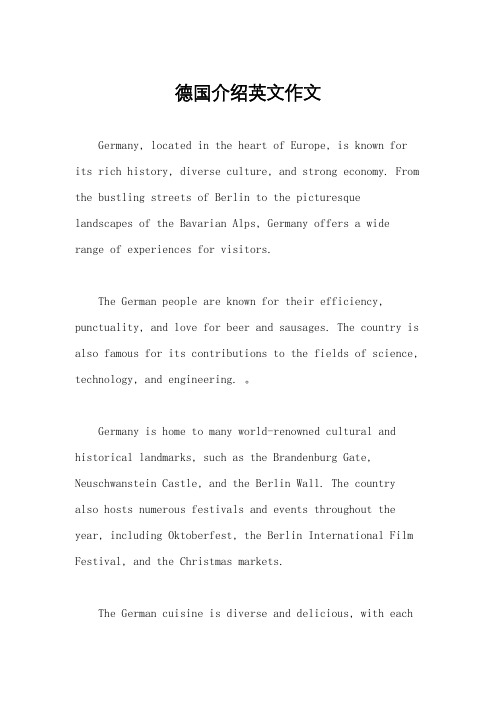
德国介绍英文作文Germany, located in the heart of Europe, is known for its rich history, diverse culture, and strong economy. From the bustling streets of Berlin to the picturesque landscapes of the Bavarian Alps, Germany offers a wide range of experiences for visitors.The German people are known for their efficiency, punctuality, and love for beer and sausages. The country is also famous for its contributions to the fields of science, technology, and engineering. 。
Germany is home to many world-renowned cultural and historical landmarks, such as the Brandenburg Gate, Neuschwanstein Castle, and the Berlin Wall. The country also hosts numerous festivals and events throughout the year, including Oktoberfest, the Berlin International Film Festival, and the Christmas markets.The German cuisine is diverse and delicious, with eachregion offering its own specialties. From the hearty dishes of Bavaria to the seafood of the North Sea, there is something for every palate in Germany. 。
德国简介作文英文

德国简介作文英文Germany is a country located in central Europe. It is known for its rich history, diverse culture, and strong economy. The capital city is Berlin, which is also the largest city in the country. Germany is famous for its beer, sausages, and the Autobahn, which is a highway system with no speed limit in some areas.The country has a population of over 83 million people, making it the most populous country in the European Union. Germany is a federal parliamentary republic, with Angela Merkel serving as the Chancellor since 2005. The country is also a founding member of the European Union and the Eurozone.Germany is home to many famous historical figures, such as Ludwig van Beethoven, Johann Wolfgang von Goethe, and Albert Einstein. It has also made significant contributions to the fields of science, technology, and philosophy. The country is known for its efficient public transportationsystem and its commitment to renewable energy.The German language is the official language of the country, but English is widely spoken and understood, especially in major cities and tourist areas. The country has a strong tradition of literature, music, and art, andis known for its classical music composers such as Bach, Mozart, and Brahms.Germany is a popular tourist destination, with millions of visitors coming to see its historic landmarks, beautiful countryside, and vibrant cities. Some of the most famous attractions include the Brandenburg Gate, Neuschwanstein Castle, and the Black Forest. The country also hosts numerous cultural events and festivals throughout the year.In conclusion, Germany is a fascinating country with a rich cultural heritage and a strong influence on the world stage. It is a place where tradition meets modernity, and where visitors can experience the best of both worlds. Whether it's exploring historic sites, enjoying the localcuisine, or simply taking in the beautiful scenery, Germany has something to offer for everyone.。
德国简介作文英文
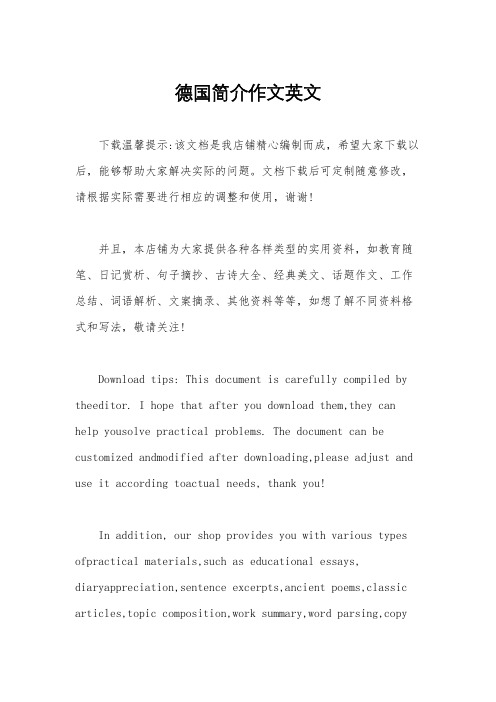
德国简介作文英文下载温馨提示:该文档是我店铺精心编制而成,希望大家下载以后,能够帮助大家解决实际的问题。
文档下载后可定制随意修改,请根据实际需要进行相应的调整和使用,谢谢!并且,本店铺为大家提供各种各样类型的实用资料,如教育随笔、日记赏析、句子摘抄、古诗大全、经典美文、话题作文、工作总结、词语解析、文案摘录、其他资料等等,如想了解不同资料格式和写法,敬请关注!Download tips: This document is carefully compiled by theeditor. I hope that after you download them,they can help yousolve practical problems. The document can be customized andmodified after downloading,please adjust and use it according toactual needs, thank you!In addition, our shop provides you with various types ofpractical materials,such as educational essays, diaryappreciation,sentence excerpts,ancient poems,classic articles,topic composition,work summary,word parsing,copyexcerpts,other materials and so on,want to know different data formats andwriting methods,please pay attention!Germany is a country located in the heart of Europe. It is known for its rich history, vibrant culture, and strong economy. The country is home to beautiful landscapes, bustling cities, and friendly people.One of the things that Germany is famous for is its efficiency. Germans are known for their punctuality and precision. Everything in Germany seems to run like clockwork, from public transportation to government services. This efficiency is reflected in the country's strong economy, which is one of the largest in the world.Germany is also a country of great diversity. It is home to people from different ethnic backgrounds and cultures. This diversity is celebrated in the country's many festivals and events. From Oktoberfest in Munich to the Berlin International Film Festival, there is always something happening in Germany.When it comes to food, Germany is known for its hearty and delicious cuisine. Traditional German dishes such as bratwurst, sauerkraut, and pretzels are popular around the world. German beer is also famous, with the country being home to many breweries.In terms of education, Germany is known for its high-quality universities and research institutions. Many international students come to Germany to study, attracted by the country's excellent education system. The country is also known for its strong emphasis on vocational training, which prepares students for a wide range of careers.Germany is a country that values nature and the environment. It is home to many beautiful natural landscapes, including the Black Forest, the Bavarian Alps, and the Rhine River. Germans are passionate aboutprotecting the environment, and the country is a leader in renewable energy and sustainability.In conclusion, Germany is a country that offers a unique blend of history, culture, and modernity. From itsefficient infrastructure to its diverse population, there is always something interesting happening in Germany. Whether you are interested in history, food, nature, or education, Germany has something to offer everyone.。
- 1、下载文档前请自行甄别文档内容的完整性,平台不提供额外的编辑、内容补充、找答案等附加服务。
- 2、"仅部分预览"的文档,不可在线预览部分如存在完整性等问题,可反馈申请退款(可完整预览的文档不适用该条件!)。
- 3、如文档侵犯您的权益,请联系客服反馈,我们会尽快为您处理(人工客服工作时间:9:00-18:30)。
Germany is divided into four topographic regions, with southern areas higher than the north. Many rivers flow over Germany and there are a lot of big lakes as well.
德国地理形势
The geography of Germany
初二四班 安天琦
German flag is made up of three colors, black, red and yellow.
The song of Germany is full of justice and freedom.
The territory of Germany covers 357,020 km2,
ranking the seventh in Europe.
地势北低南高,分为四个地形区: 北德平原,平均海拔不到100米;中德山地, 由东西走向的高地块构成;西南部莱茵断裂谷 地区,两旁是山地,谷壁陡峭;南部的巴伐利 亚高原和阿尔卑斯山区,其间拜恩阿尔卑斯山 脉的主峰楚格峰海拔2963米,为全国最高峰. 主要河流有莱茵河(流经境内865公里)、易 北河、威悉河、奥得河、多瑙河。 较大湖泊有 博登湖、基姆湖、阿莫尔湖、里次湖。
There is a dark eagle on the national emblem , which stands for strength and courage.
地理特征
geography 德国位于欧洲西部,东邻波兰、捷克,南 接奥地利、瑞士,西接荷兰、比利时、卢森堡、 法国,北与丹麦相连并邻北海和波罗的海与北 欧国家隔海相,是欧洲中部邻国最多的国家 。
Germany is in western Europe, boarding a lot of countries, so it is at the top of the neighboring countries of central Europe.
德国边境线全长3758公里,从最南部的巴 伐利亚州奥伯斯特道夫到最北边济特岛上的里 斯特,相距876公里;从东端的萨克森州泰斯 特至西端的北莱茵 - 威斯特法伦州塞尔康特距 离640公里。全国总面积为357 020平方公里。
气候
• 德国的纬度相当于中国的黑龙江省,.但气候和昆明比较相似。 德国位于大西洋和东部大陆性气候之间的凉爽西风带, 温差 不算大。冬季无寒冬,夏季无酷暑冬季多雨水,阴天多阳光 少。早晚温差大。冬季平均温度在平原低地1.5°C与山区零 下6°C之间,七月份平原低地平均温度为8°C,南方有屏障 的山谷为20°C左右。西北部海洋性气候较明显,往东、 南 部逐渐向大陆性气候过渡。年降水量500~1000毫米,山 地则更多。
German climate is similar to that of Kun Ming. Winters there are warm and summers are cool. The average rainfall is between 500 and 1000mm, with a higher rainfall in mountainous areas.
